About Canon eos 500D
Wednesday, June 24, 2009
Ease of Use
The Canon EOS 500D is virtually identical to its predecessor, the EOS 450D, with the only notable additions being a HDMI connection, speaker and microphone holes and a shiny silver mode dial. The camera's dimensions are exactly the same (128.8 x 97.5 x 61.9 mm) and the weight too (480g). You'd be hard-pressed to tell the two cameras apart if their name badges were hidden. Holding the camera is slightly awkward because the EOS 500D's comparatively small body size means that the grip isn't particularly deep and people with large hands (like me) may find that their little finger has nowhere to go. Definitely something to consider, and worth a trip to your local camera shop to try out the 500D in person. The Canon EOS 500D looks and feels more expensive than it actually is, and certainly solid enough for a mid-range DSLR, although not in the same league as the EOS 50D model.
We tested the EOS 500D with the EFS 18-55mm f/3.5-5.6 IS kit lens, which was first introduced alongside the 450D. As the name suggests, this lens has image stabilisation, an important factor given that competitors like Sony, Olympus and Pentax all offer image stabilisation in their DSLRs. The difference between Canon (and Nikon) and the others is that Sony, Olympus and Pentax have opted for stabilisation via the camera body, rather than the lens, which therefore works with their entire range of lenses. Canon's system is obviously limited by which lenses you choose, but it does offer the slight advantage of showing the stabilising effect through the viewfinder. Canon and Nikon also claim that a lens-based anti-shake system is inherently better too, but the jury's still out on that one.
Like most entry- and mid-level DSLRs the EOS 500D provides a number of auto shooting modes aimed at beginners, including portrait, landscape, close-up, sports and night portrait and flash off choices. All of these functions performed adequately, apart from the close-up macro mode that did not come near to offering a true 1:1 reproduction (you'll need a dedicated macro lens for that). There are, of course, manual and semi-automatic modes for users who want more advanced exposure control.
Canon refers to these advanced operations as the 'creative zone' and provides all the normal settings including Program, Aperture and Shutter Priority and the full manual mode. Additionally, they provide the 'A-DEP' (Automatic Depth of Field) function that gives a wider depth of field between a near and far subject. New for the EOS 500D is the Creative Auto (CA) mode, which as the name suggests provides a half-way house between full auto and the more advanced shooting modes. First featured on the more expensive 50D model, this mode is targeted at beginners who have grown out of using the Full Auto mode, allowing you to change a few key settings using the LCD screen, with a simple slider system for changing the aperture and exposure compensation, or Background and Exposure as the camera refers to them.
Once the EOS 500D is in the 'creative zone' users can adjust the ISO setting into one of eight positions from 100 to 12800, a versatile range that is more than adequate for virtually any lighting conditions. This expansion is a very welcome move by Canon which surpasses most of its competitors. The EOS 500D offers a range of three Auto focus modes (One Shot, AI Focus and AI Servo) and there's also a 9-point wide-area AF system with an f/2.8 cross-type centre point. There are seven preset, auto and custom white balance options, and Canon have included a Spot mode, covering 4% of the viewfinder, along with the other three metering modes, which is a very useful addition for more experienced photographers. The viewfinder displays the key exposure information including ISO speed.
 | 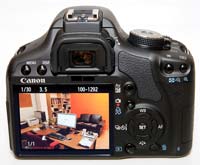 |
| Front | Rear |
Most of the 500D's buttons are located logically on the rear of the camera, although the large 3 inch screen does make the overall layout a little complicated. It offers quick access to the Continuous modes, Auto Focus, Metering modes and Picture Styles via its circular four-way controller. There's an ISO button on top of the camera near the aperture/shutter speed control dial, which provides easier access when looking through the viewfinder. Aperture and shutter speed settings can be easily adjusted with the index finger on the well-positioned dial, but it's annoying that you have to hold down the Exposure Compensation button to change the aperture in Manual mode, rather than just press it once to toggle between shutter speed and aperture.
First introduced on the EOS 450D, Live View has been slightly improved. If you're new to DSLRs and don't understand the terminology, basically Live View allows you to view the scene in front of you live on the LCD screen, rather than through the traditional optical viewfinder. This is an obvious attraction for compact camera users, who are familiar with holding the camera at arm's length and composing via the LCD screen. It's also appealing to macro shooters, for example, as it's often easier to view the screen than look through the viewfinder when the camera is mounted on a tripod at an awkward angle.
Once enabled, Live View is now activated by pressing the Live View / Print Transfer button on the rear of the camera. A grid line display and very useful live histogram can be enabled to help with composition and exposure, and you can zoom in by up to 10x magnification of the image displayed on the LCD screen. Focusing is achieved via the AF / AE Lock button, rather than half-pressing the shutter-button. Live View can also be controlled remotely using the supplied EOS utility software, which allows you to adjust settings and capture the image from a PC.
There are now three types of focusing system on offer in Live View mode. The first, Quick AF, works by physically flipping the camera mirror to engage the auto-focus sensor, which then momentarily blanks the LCD screen and causes a physical sound, before the image is displayed after about 1 second. The second method, Live AF, uses an image contrast auto-focus system, much like that used by point-and shoot compacts, the main benefits being the complete lack of noise during operation, and no LCD blackout. Unfortunately this is much slower than the Quick AF mode, taking over 3 seconds to focus on a clearly-defined subject in bright light, which I think will put off most users that are attracted by the promised point-and-shoot experience. The new third method, Face Detection AF, uses the same contrast auto-focus system as Live AF, with the addition of being able to detect human faces and set the largest face closest to the center of the frame as the AF point. It also suffers from the same 3 second focus lag.
Live View is also used for the feature that will arguably generate the most interest in the Canon EOS 500D: its movie mode. This is the second Canon DSLR camera to shoot full 1080p HD quality video, following on from the pro-level Canon EOS 5D Mark II. The 500D works almost in exactly the same way, recording high-definition, wide-screen video in 1920 x 1080 pixel resolution in MOV format using the H.264 codec. Strangely, though, it only does so at a frame rate of 20fps, rather than the 30fps offered by the 5D Mark II. Drop down to the 500D's 720p video mode, and the frame rate is 30fps. Video can also be recorded in 640x480 VGA quality at 30fps.
The maximum size of a single video clip is either 4 gigabytes or one second below 30 minutes. You can also take either single or continuous stills during recording, with video capture continuing after the final still frame has been taken. Audio is recorded in linear PCM format without any compression. There's a built-in microphone on the front of the camera for mono recording, but sadly there's no socket for connecting an external stereo microphone, as on the 5D Mark II. It also has an HDMI port for playing back 1920 x 1080 still images on a HD TV. It uses the industry-standard HDMI mini-out connection, but note that you'll need to purchase a suitable cable separately. You can also still connect the 500D to a standard TV set via NTSC/PAL. By offering video capture in a DSLR, Canon has made it possible for filmmakers to play with depth of field the way they never could, taking advantage of the relatively big APS-C image sensor and the wide assortment of Canon lenses.
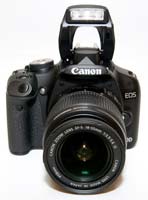 | 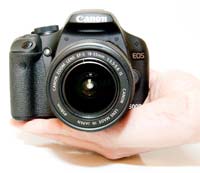 |
| Pop-up Flash | Front |
There are, however, some notable drawbacks to the Canon EOS 500D's video mode. For a camera making such a big noise about its video mode, it's quite difficult to actually start recording one. You have to set the Mode Dial to the Movie mode, then the AF-On button to set the focus, then press the Live View button on the rear of the camera to begin recording (with the same button ending the movie). It's a big improvement on the 5D Mark II's even more convoluted method, but not on a par with the one-touch system that rivals offer. Although you can autofocus during movie recording, the camera uses the painfully slow contrast-AF mode, and even the user guide warns against trying to auto-focus. Focusing manually is a much better idea, although most AF lenses have MF rings with very little 'travel' between their close-focus point and infinity, and in a quiet environment it's also possible to hear the sound of the focusing ring in the video.
You can't set the aperture from the camera in movie mode, so you will want to use lenses that have an aperture ring if possible. Similarly the shutter speed cannot be set by the user in movie mode either, so you will have to rely on the camera's auto-exposure system while filming. You can take a single/sequence of still shots whilst shooting video, but this causes a 1 second delay which you'll need to edit out later. Handholding the EOS 500D and shooting video is very difficult, with the DSLR form factor not lending itself well to controlled shooting at arm's length. It's a much better idea to mount the camera on a dedicated video tripod. Casual users hoping to grab some quality footage of the kids may be put off by the inherent difficulties of shooting video using the relatively alien SLR format.
The new, higher-resolution 3 inch LCD screen gives an excellent, clear view of your pictures from wide viewing angles, and when compared to the older 450D, the new screen provides more accurate feedback on a picture's exposure and color reproduction. With 920,000-dots, this large screen is a great way to show off your images to friends and family, and will therefore definitely appeal to its target audience. By default, the current camera settings are displayed on the LCD screen. This can be turned off by pressing the Display button, and there's also a new handy sensor underneath the viewfinder, which detects that you're looking through it and turns off the LCD display to both save power and stop it from distracting you (this can be enabled or disabled in the main menu).
The Canon EOS 500D's dust-removal technology, where the sensor is shaken briefly at high frequency to dislodge any dust particles from its surface, has been upgraded with a fluorine coating on the low-pass filter for better dust resistance. This could delay the need for manual sensor cleaning, perhaps indefinitely, but it won't be able to remove ‘sticky' deposits like salt spray, pollen or the smears left behind by careless sensor cleaning or the wrong kind of solvent. The EOS 500D also features the internal Dust Delete Data system which can map the position of visible dust on the sensor. This can then be deleted automatically after the shoot with the supplied Digital Photo Professional software.
Peripheral Illumination Correction is a new addition that's actually a lot simpler that it initially sounds. Basically it corrects the unwanted effects of vignetting, typically seen in wide-angle photos in the corners of the frame. The 500D contains a database of correction data for 26 Canon lenses and, if Peripheral Illumination Correction is enabled, automatically applies it to JPEG images. For RAW images the correction is applied later in the Digital Photo Professional software. Up to 40 lenses can be programmed into the 500D, with over 80 currently available to choose from. Peripheral Illumination Correction is a useful and effective addition, particularly for JPEG shooters, and can safely be left turned on all of the time.
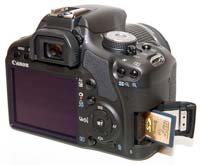 | 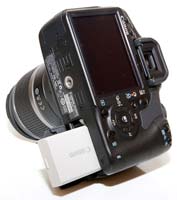 |
| Memory Card Slot | Battery Compartment |
The main menu system is inherited from the professional EOS cameras, with a simplified tab structure that does away completely with scrolling. There are 8 tabs, with up to 7 options in each one, providing quick and easy access to the various options. You can even setup your own customised menu page for instant access to frequently used settings via the My Menu tab. Pressing the Display button when using the Menu system displays all of the camera's current key menu settings laid-out for easy viewing on the LCD screen.
The Canon EOS 500D uses the same LP-E5 battery pack as the EOS 450D's, with a capacity of 1080mAh. This extends shooting time on a single charge to a claimed maximum of 400 shots (down from the 450D's 500 shots) - I managed around 350 and a few movie clips before the battery ran out. The 500D uses SD memory cards, not CompactFlash, again just like its predecessor. If you have never used a digital camera before, or you're upgrading from a more basic model, reading the comprehensive but relatively easy-to-follow manual before you start is a good idea. Thankfully Canon have chosen to supply it in printed format, rather than as a PDF on a CD, so you can also carry it with you.
The start-up time of the Canon EOS 500D, from turning the camera on to being ready to take a photo, is quite quick at around 2 seconds. Focusing is blazingly quick and very consistent in good light with the standard 18-55mm kit lens, with the wide-area 9-point AF system offering generous scene coverage, and the camera happily achieves focus indoors and in low-light situations. It takes less than a second to store a JPEG image at the highest quality setting with no discernible lockup between taking shots, allowing you to keep shooting as they are being recorded onto the memory card. For RAW images the Canon EOS 500D is impressively just as quick, again with no discernible lockup between shots. In the continuous shooting mode you can hold down the shutter button and take 3.4 shots per second for up to 70 JPEGS and 9 RAW files, a slight improvement on the EOS 450D and impressive for an entry-level model. All in all a great performance given the large 15 megapixel files that this camera produces.
Once you have captured a photo, the Canon EOS 500D has an average range of options for playing, reviewing and managing your images. More information about a captured image can be seen on the LCD by pressing the Display button, which brings up an image histogram and all the shooting Exif data, including shutter speed and the time and date it was captured, with a second press displaying an additional RGB histogram. It is simple to get a closer look at an image as users can zoom in up to 15 times, and it is also possible to view pictures in a set of nine contact sheet.
You can also delete an image, rotate an image, view a slideshow, protect images so that they cannot be deleted, and set various printing options. Unlike some competitors, there are no digital styles or effects that can be applied to an image after it has been taken - the more subtle Picture Styles are the only way of tweaking your JPEGs in-camera. The camera shows you a preview of what the effect will look like when applied, and the effect is applied to a copy of your image, thus preserving the original intact.
In summary the Canon EOS 500D is visually very similar to the previous 450D model, but adds a number of key improvements, most notably the higher-resolution LCD screen and expanded ISO range. Video recording is a headline grabbing addition which suffers from some limitations that will put off the casual user.









[get this widget]




